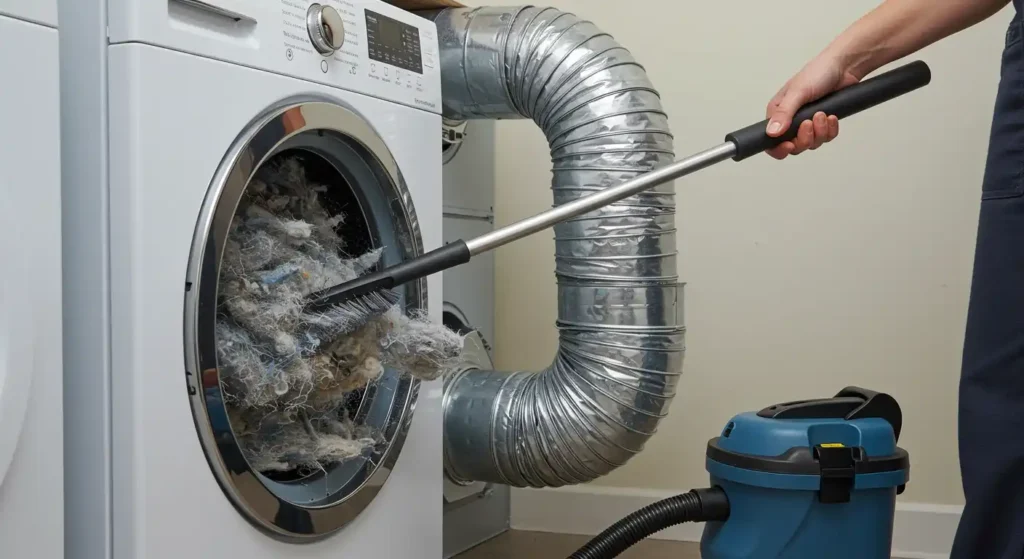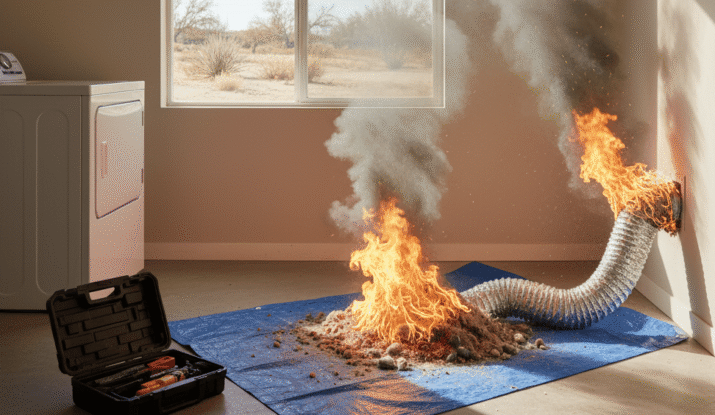Dryer Vent Fire Risks in Texas Homes and How to Prevent
Last summer in Katy, a family called because their laundry room smelled hot and “burnt” after each load. The dryer was new. The problem was not the machine. A bird had built a nest in the dryer vent cap, which created a dryer vent fire hazard. Lint stacked up behind it. Airflow collapsed. Their towels were taking two cycles, and the top of the dryer felt unusually warm. We cleaned the dryer vent line, cleared the nest, and fixed the dryer vent termination. The smell disappeared, and drying time dropped back to one cycle.
That is how simple a clogged dryer vent can be, tipping toward a dryer vent fire if no one checks it.
How Dryers Catch On Fire
People ask, How do dryers catch on fire, and What causes a dryer fire. It is almost always the same chain. Lint is dry fuel. Airflow gets restricted. Heat builds up. The restriction can be crushed flex, too many elbows, long roof runs, a jammed damper, or a bird nest in the dryer vent fire hazard. Add high heat and time, and smoldering can start. In short, dryer fire follows the triangle of fuel, heat, and poor airflow.
Use the same idea to explain what causes clothes dryer fires to customers. If lint cannot leave the home quickly, heat stays in the dryer too long and can ignite lint or clothing.
How Common Are Dryer Fires
You will see different numbers by year, but dryer vent fires happen thousands of times across the United States each year, with “failure to clean” often listed as the top factor. When you read dryer vent fire statistics, the pattern is clear. Lint buildup and neglected vents are the core problem, not exotic electrical faults.
Temperature And Heat Load
The temperature of the dryer vent exhaust can get very hot during a cycle, often well above typical room-safe levels. That heat is normal when airflow is strong and unrestricted. Heat becomes dangerous when it is trapped behind blockages. If the room feels too warm, or the dryer’s top stays hot long after the cycle, treat that as a warning for clothes dryer vent safety.
Dryer Fire Warning Signs You Should Never Ignore
These are the everyday clues homeowners notice first. Treat any one of them as a reason to check the dryer vent route.
• Loads keep getting longer than 45 to 60 minutes.
• Lint is collecting behind or under the dryer.
• The flap at the exterior hood barely opens while the dryer runs.
• The room feels humid and hot during cycles.
• A burnt or musty smell near the dryer
• The dryer shuts off mid-cycle and needs a long cool-down
• Each item points to restricted airflow and a growing dryer fire hazard. If you see two or more, stop and schedule cleaning right away. That is smart dryer fire prevention.
Five High-Risk Blockers In Texas Homes
Roof Terminations
Many two-story homes in Texas vent through the roof. Long runs and multiple elbows raise the “equivalent length,” which weakens airflow. Poor airflow feeds dryer vent fires.
Bird Nests And Insects
A stuck damper or nest is a classic bird nest in a dryer vent fire hazard. If you cannot feel strong air at the hood, assume trouble.
Crushed Connectors
The short connector behind the dryer gets pushed flat when the dryer is shoved back. That single kink can turn into a dryer vent fire hazard quickly.
Wrong Materials
Thin foil or plastic connectors crush and trap lint. Use a listed, high-quality transition and smooth metal duct out of the wall for better clothes dryer vent safety.
Post-Storm Debris
After storms or roof work, caps can jam with shingle grit and leaves. Always recheck airflow to prevent dryer fires.
Simple Code Basics Homeowners Can Use
You do not need to memorize the book; remember these rules that protect you from a dryer vent fire.
• Route the dryer vent outside and use a free-swinging backdraft damper. No screens at the cap
• 4-inch smooth metal duct for the dryer vent run inside walls and attics
• Keep the dryer vent route short and straight. Every elbow steals airflow
• Typical maximum equivalent length is about 35 feet, unless your dryer manual allows more
• When a dryer vent route must be longer, a listed booster (DEDPV) may be permitted if installed and maintained correctly
• Used together, these basics reduce dryer fire causes tied to poor design.
DIY Maintenance That Actually Works

• Clean the lint screen every load. Wash it monthly with warm water and a little dish soap to remove residue
• Pull the dryer out gently, disconnect the power, and vacuum the area behind it
• Inspect the connector. Replace crushed or damaged transitions with a listed, heavy-duty one
• Go outside while the dryer runs. You should feel a strong push of air and see the flap open fully
• These steps are the backbone of clothes dryer fire prevention at home.
When To Call A Pro
Call a professional when any of these happen:
• Drying time keeps increasing.
• You smell a burn or see dark scorch on the connector.
• The exterior flap does not open or stays stuck.
• You suspect a roof or long-term blockage.
• A proper service will brush and vacuum the full dryer vent line, verify the dryer vent cap and damper, and document the route so you can track future changes. This is practical dryer fire prevention that targets the real dryer fire causes.
What Pros Check On Every Visit
• Dryer vent route and equivalent length against manufacturer guidance
• Material and size from the dryer to the dryer vent termination
• Dryer vent termination opens fully with no screen
• Full-length cleaning of the cap and a clear photo set before and after
• Airflow confirmation at the exterior hood
• A visit like this eliminates the most common dryer fire scenarios before they start.
Texas Checklist To Prevent Dryer Fires
• Clean the lint screen every load
• Wash the screen monthly
• Keep the connector short, smooth, and undamaged
• Verify strong airflow at the cap while the dryer runs
• Schedule annual dryer vent cleaning, sooner if symptoms appear
• Recheck the dryer vent after storms, pest activity, or roof work
• Follow this list, and you will handle clothes dryer fire prevention the right way.
Need Help: Book Your Dryer Vent Safety Service

If you are in Houston, The Woodlands, Spring, Tomball, Magnolia, Conroe, or nearby in Texas, Mighty Ducts of Texas can inspect, clean, and fix problem terminations. We show you photos before and after, and give a simple plan to prevent dryer fires the smart way.
Ready to stop long cycles and remove hidden fire risks
• Schedule a code-compliant cleaning and route check today
• Get photos, airflow confirmation at the cap, and a clear maintenance plan
• Protect your family and your home from a dryer vent fire
Start now with Mighty Ducts of Texas and dry your laundry faster and safer.

